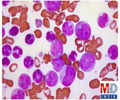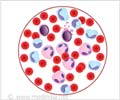The new study uncovers the efficacy of fixed-duration combination treatment in patients with high-risk leukemia.

Outcomes in Patients with High-Risk Features after Fixed-Duration Ibrutinib plus Venetoclax: Phase II CAPTIVATE Study in First-Line Chronic Lymphocytic Leukemia
Go to source). For many years, patients with high-risk CLL had limited treatment options due to a lack of response to chemoimmunotherapy, the former standard of care for CLL.
‘Fixed-duration ibrutinib and venetoclax is beneficial as first-line treatment for chronic lymphocytic leukemia. #cancerdrugs’





Recently, the standard of care for CLL has moved away from chemoimmunotherapy to first-line targeted therapy regimens, such as those involving inhibitors of Bruton’s tyrosine kinase (BTK) or BCL-2 with or without CD20-directed antibody therapy, explained John Allan, MD, an associate professor of clinical medicine at Weill Cornell Medicine. Allan and colleagues previously reported results from the phase II CAPTIVATE trial, which showed that patients with CLL experienced durable responses to fixed-duration first-line treatment with the BTK inhibitor ibrutinib in combination with venetoclax. As opposed to continuous treatment, fixed-duration treatment is administered for a limited amount of time to reduce the risk of toxicities or treatment resistance.
Combination Therapy in Combating Cancer
The latest publication reports outcomes of a subgroup of patients in the CAPTIVATE trial who were treated with fixed-duration ibrutinib plus venetoclax and whose baseline genetic risk features were known. Of the 195 patients included in this subgroup, 129 had high-risk CLL and 66 had low-risk CLL.Over 95% of these patients had responses to the combination therapy, regardless of whether their CLL harbored high-risk genetic features, and 61% and 53% of patients with and without high-risk disease, respectively, had complete responses.
Eighty-eight percent of patients with high-risk CLL and 92% of patients without high-risk CLL experienced PFS of at least 36 months. Moreover, more than 95% of patients with and without high-risk CLL were alive 36 months after beginning treatment.
“Previously reported results from the CAPTIVATE study demonstrated deep and durable responses with sustained PFS after fixed-duration therapy with ibrutinib plus venetoclax for first-line treatment of CLL,” said Allan. “The current analysis builds upon those results by demonstrating that these clinical outcomes are maintained at these early time points in patients with CLL harboring high-risk genomic features. While further follow-up is required to understand longer term outcomes, these results support fixed-duration ibrutinib plus venetoclax as a treatment approach for this patient population.”
Advertisement
Fixed-duration ibrutinib and venetoclax led to similar adverse events regardless of the presence of high-risk genetic features, Allan added. The most common adverse events were diarrhea, neutropenia, nausea, and arthralgia in both groups. Serious adverse events were observed in 22% and 21% of patients with and without high-risk CLL, respectively.
Advertisement
The study was funded by Pharmacyclics LLC, an AbbVie company. Allan has received grants and/or personal fees from Pharmacyclics LLC, AbbVie, Adaptive Biotechnologies, AstraZeneca, BeiGene, Lilly, Genentech, Janssen, and TG Therapeutics.
Reference:
- Outcomes in Patients with High-Risk Features after Fixed-Duration Ibrutinib plus Venetoclax: Phase II CAPTIVATE Study in First-Line Chronic Lymphocytic Leukemia - (https://aacrjournals.org/clincancerres/article/doi/10.1158/1078-0432.CCR-22-2779/726933)














